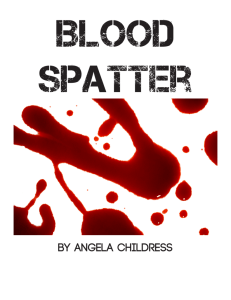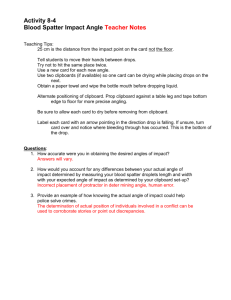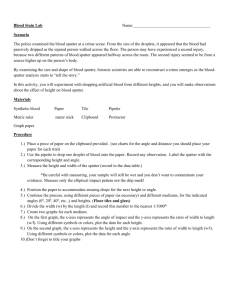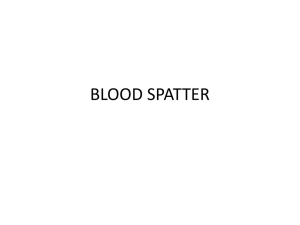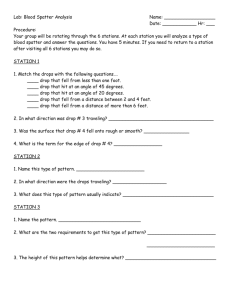Forencis Science- Forensic dental evidence
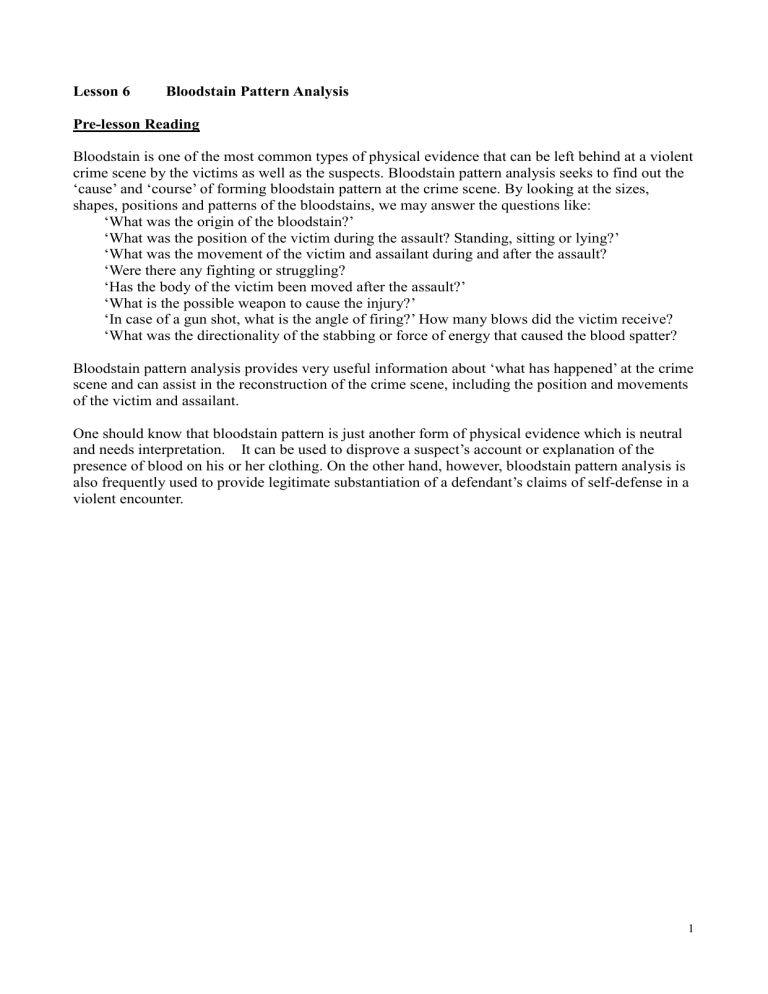
Lesson 6 Bloodstain Pattern Analysis
Pre-lesson Reading
Bloodstain is one of the most common types of physical evidence that can be left behind at a violent crime scene by the victims as well as the suspects. Bloodstain pattern analysis seeks to find out the
‘cause’ and ‘course’ of forming bloodstain pattern at the crime scene. By looking at the sizes, shapes, positions and patterns of the bloodstains, we may answer the questions like:
‘What was the origin of the bloodstain?’
‘What was the position of the victim during the assault? Standing, sitting or lying?’
‘What was the movement of the victim and assailant during and after the assault?
‘Were there any fighting or struggling?
‘Has the body of the victim been moved after the assault?’
‘What is the possible weapon to cause the injury?’
‘In case of a gun shot, what is the angle of firing?’ How many blows did the victim receive?
‘What was the directionality of the stabbing or force of energy that caused the blood spatter?
Bloodstain pattern analysis provides very useful information about ‘what has happened’ at the crime scene and can assist in the reconstruction of the crime scene, including the position and movements of the victim and assailant.
One should know that bloodstain pattern is just another form of physical evidence which is neutral and needs interpretation. It can be used to disprove a suspect’s account or explanation of the presence of blood on his or her clothing. On the other hand, however, bloodstain pattern analysis is also frequently used to provide legitimate substantiation of a defendant’s claims of self-defense in a violent encounter.
1
Terminology
Bloodstain pattern: It includes all kind of bloodstain patterns including spatter and non-spatter stains such as swipes, pattern transfer or blood pooling.
Spatter: A family of stains resulting from impact of free-flight blood droplets on a surface. Each spatter stain has a circular or elliptical shaped parent stain.
Impact patterns: Blood dispersed from a point source by force.
Directionality of impact: The direction which a blood droplet moves when it hits a surface.
Angle of impact: The angle at which a blood droplet hits a surface. tangent
Surface tension: A cohesive force caused by the attraction of the molecules at the surface of a liquid to each other.
It tends to minimise the total surface area of the liquid.
Colloidal liquid: A liquid that has solid particles suspended in it.
Tangent: A tangent line (or simply the tangent) to a curve at a given point is the straight line that "just touches" the curve at that point. (Figure 1) Figure 1 A tangent
Trigonometry
Consider angle A in a right-angled triangle ACB
(Figure 2),
The sine function (sin) is defined as the ratio of the opposite side to the hypotenuse. sin A
opposite hypotenuse
a c
The cosine function (cos) is defined as the ratio of the adjacent side to the hypotenuse.
Figure 2 A right-angled triangle cos A
adjacent hypotenuse
b c
The tangent function (tan) is defined as the ratio of the opposite side to the adjacent side. tan A
opposite adjacent
a b
2
On-line studying
1.
How bloodstain pattern analysis works? http://www.howstuffworks.com/bloodstain-pattern-analysis.htm/printable
2. Interpreting Bloodstain Patterns http://www.crimescene-forensics.com/Blood_Stains.html
3. Bloodstain analysis http://douglashagmann.com/?page_id=25
4. Process of Evaluating Blood Spatter Evidence at a Crime Scene http://crime-scene-processing.suite101.com/article.cfm/forensic_bloodstain_pattern_analysis#ixzz0iQBIi3tz
3
Lesson 6 Bloodstain Pattern Analysis
Worksheet 6.1 Seeing red blood spatters (30 mins)
Introduction:
Imagine what happens when you spill water droplets onto the floor. The water falls slowly to the ground, making a circular puddle. The shape and size of the puddle depends on how much water you pour, how high you hold the water glass and whether you are spilling it on the carpet, wood or some other surface.
Blood pattern analysis can lead to the crime scene reconstruction because how blood behaves when it comes into contact with a surface is predictable and reproducible. Blood is a colloidal fluid which contains some insoluble substances including blood cells suspending in it. Like other fluids, it is generally incompressible. Its shape is influenced by the surface tension as well as external forces.
The surface tension tends to minimise the total surface area. Therefore, a free-flight or free-falling blood drop is approximately spherical. When it hits a surface, its surface tension breaks and a blood spatter is formed.
The pattern of a blood spatter depends on many factors including the materials of the contact surface, the speed of the blood droplet, the angle of impact and the force producing the eruption of blood. In this activity, we will study how the contact surface materials affect the shape of blood spatters.
Objective:
To investigate the effect of surface materials on the shapes and boundaries of blood spatters
Apparatus (per group):
Dropper x 1
Clamp and stand x 1
Meter rule x 1
Plastic CD case x 1
Glass plate (8 cm x 8 cm)
Heat proof mat
Materials (per group):
Red latex paint-water (1:1) mixture x 20 ml
Cardboard (8 cm x 8 cm)
Table cloth (8 cm x 8 cm)
Sponge (8 cm x 8 cm)
Bandage
Newspaper x 5 pieces
100 ml beaker x 1
Precaution:
The red latex paint-water (1:1) mixture is used to simulate blood. Note that the mixture may be an irritant to some people and it may stain fabrics and other materials. Wear safety spectacles, protective gloves and laboratory gown or apron. Take great care not to get any of the liquid on you body and clothing.
Procedure:
1) Cover the bench surface with newspaper.
2) Set up the apparatus as shown in the diagram below. Use clamp and stand to hold a dropper vertically with the tip about 30 cm above the bench surface.
4
3) Add about 20 ml of the red latex paint-water mixture (simulated blood) in a 100 ml beaker.
Fill the dropper with this liquid.
4) Place a plastic CD case horizontally under the dropper. Release 5 separate drops of simulated blood to the surface. Move the surface a little so that each drop will form a separate blood spatter.
(You have to squeeze the bulb a little to remove all air bubbles inside the dropper and practice several times how to release liquid dropwisely)
5) Observe and draw the shape of the blood spatter in the result table. Outline its boundary clearly.
6) Repeat (4) – (5) with other surfaces.
7) Deduce how the surface materials affect the shapes of blood spatters.
5
Results:
Draw the shapes of blood spatters in the spaces provided. Outline the boundary of each blood spatter clearly. a) Plastic CD case b) Table cloth c) Glass plate d) Sponge
6
e) Heat proof mat g) Cardboard f) Bandage h) Newspaper
7
Interpretation and Deduction:
1.
Comparing the shapes and boundaries of the blood spatter patterns, how would you classify them into two main groups? Use a tree diagram to show the classification of your results.
Shape of Blood Spatter
Description of shape and boundary: Description of shape and boundary:
Materials you have used: Materials you have used:
Heat proof mat, Table cloth,
2.
Deduce how the materials of the surface influence the shapes and boundaries of the blood spatter?
8
3.
Based on your classification and deduction, predict what kind of boundaries the blood spatters will have if blood is dropped onto the following surfaces: b) sandy beach a) cotton c) the hood of a car d) floor tile
Conclusions:
Write a few sentences to conclude your findings in this experiment.
9
Worksheet 6.2 Directionality of Impact (15 mins)
1. Determining directionality of impact a) The following blood spatter is formed when a blood droplet hits a surface at an acute angle. Draw an arrow in the diagram to show its directionality of impact which is the direction of movement of the blood droplet when it hits the contact surface.
Question: b) Give reasons to support your prediction.
10
1.
Identifying the features of blood spatters
Write down the names of the features of blood spatters in the spaces provided.
Source: http://science.howstuffworks.com/bloodstain-pattern-analysis3.htm
(HowStuffWorks, Inc.)
11
Worksheet 6.3 Angle of Impact (40 mins)
1. Mathematical formula of angle of impact
A free-flight blood droplet is approximately spherical in shape, which has the same diameter in all directions. When it impacts a surface at an angle, an elliptical spatter is formed. The short axis is the same as the diameter of the blood droplet, but the long axis is longer than the diameter.
In Figure 1, it shows that the diameter of the blood droplet is AC. When it hits the surface at an angle
, the long axis becomes AB. (Animation of Angle of Impact of Blood Droplet: http://projects.nfstc.org/gallery/main.php?g2_itemId=3857)
Figure 1 Figure 2
12
a) Work out a mathematical formula to relate the width AC, length AB and angle of impact
. b) Find the angle of impact for the blood spatter in figure 2.
13
2. Finding the angle of impact of a blood spatter
Introduction:
In this experiment, you will make a blood spatter at an angle to a surface and then ask your classmates to find out the angle of impact. Your teacher will assign you an angle for making the angle of impact; however, you have to tell your teacher the final angle that you have measured with the use of a protractor.
Objective:
To determine the angle of impact from the shape of a blood spatter
Apparatus (per group):
1.
Dropper x 1
2.
Clamp and stand x 1
3.
Meter rule x 1
4.
Clipboard x 1
5.
Vernier caliper x 1
6.
Newspaper x 5 pieces
Chemicals (per group):
1.
Red latex paint-water mixture (1:1) x 20 ml
7.
8.
9.
10.
11.
12.
A4 sized cardboard or paper x 2
White tile x 8
Protractor x1
20 books
Electronic calculator x 1
Precaution:
The red latex paint-water (1:1) mixture is used to simulate the blood. Note that the mixture may be an irritant to some people and it may stain fabrics and other materials. Wear safety spectacles, protective gloves and laboratory gown or apron. Take great care not to get any of the liquid on you body and clothing.
Procedure:
Part I. Making a spatter
1) Cover the bench and books with newspaper.
2) Set up the apparatus as shown in the figure 3. Use clamp and stand to hold a dropper vertically with the tip about 30 cm above the bench surface.
3) Attach an A4 sized cardboard or paper on a clipboard and place it under the dropper. Pile up some books to set the inclination of the clipboard.
You may need to place some white tiles underneath the books.
4) Calculate the angle of inclination using the following formula:
Angle of inclination = 90 o
- angle of impact
Therefore, if your assigned angle of impact is 82 o
, set the angle of inclination as 8 o .
Figure 3
14
5) Align the centre of a protractor to the point where clipboard meets the horizontal surface as shown in Figure 4. Measure the angle of inclination and record it in the angle record form.
Figure 4. The red arrow shows the point of alignment. The angle of inclination is 8 o
.
= 8 o
Figure 5. It shows an INCORRECT alignment. The blue arrow shows that the centre of protractor CANNOT align with the point where clipboard and bench surface meets.
6) Add about 20 ml of the red latex paint-water mixture (simulated blood) in a 100 ml beaker.
Fill the dropper with the liquid.
7) Release 5 separate drops of simulated blood to the cardboard or paper. Slowly move the surface horizontally while the blood is dropping so that each drop will form a separate spatter.
(You have to squeeze the bulb a little to remove all air bubbles inside the dropper and practice
several times how to release liquid dropwisely)
8) Label the paper with your group number and submit it with the angle record form to your teacher.
15
Part II. Calculating the angle of impact
Your teacher will give you a blood spatter prepared by your classmates. Find the angle of impact according to the following steps:
1) Identify the major and minor axis. Note that these two axes can bisect the elliptical structure.
2) Draw two parallel lines tangent to the ends of the short axis. With the use of a vernier caliper measure the separation distance (the length of short axis) between the parallel lines.
3) Measure the distance between the center of ellipse to initial point of contact. Multiply this distance by 2 gives the length of long axis.
4) Find the angle of impact by using the formula: sin
= length _ of length _ of
_ short
_ long _
_ axis axis
Record the answers in the result table.
Long axis
Short axis
Blood spatter Step 1 Step 2 Step 3
5) A vernier caliper can measure a distance with accuracy up to 0.05mm. Figure 6 shows that the length of short axis lies between 0.6 cm to 0.7 cm. The smaller scale indicates a linear match at
‘3.5’ which means 0.035 cm or 0.35 mm. The length of short axis is 0.635 cm or 6.35 mm.
Lies between
0.6 to 0.7 cm
Figure 6
Linear match between small scale and main scale
16
Result 1:
Group number
Length of short axis / cm
Length of long axis / cm
Angle of impact
Sketch of blood spatter
1 2
Result 2:
Group number
Angle of impact measured
Length of short axis / cm
Length of long axis / cm
Angle of impact Calculated
Sketch of spatter
5 6
Conclusions:
Write a few sentences to conclude what you have learnt in this activity.
3
7
4
8
17
Group number
Worksheet 6.3 Angle of Impact
Angle Record Form
Expected Angle of Impact
Measured angle of Impact
A
20 o
Group number
Worksheet 6.3 Angle of Impact
Angle Record Form
Expected Angle of Impact
Measured angle of Impact
B
45 o
Group number
Worksheet 6.3 Angle of Impact
Angle Record Form
Expected Angle of Impact
C
60 o
Measured angle of Impact
Group number
Worksheet 6.3 Angle of Impact
Angle Record Form
Expected Angle of Impact
Measured angle of Impact
D
90 o
18
Worksheet 6.4 Case Reconstruction-Finding the Point of Origin (90 mins.)
Introduction:
Identifying the directionality and the angle of impact can help find the point of origin of the blood spatter, which provides useful information for case reconstruction: the height and position of the blood source.
‘Stringing technique’ is a basic method for locating the point of origin of a blood spatter. Assuming a blood spatter is found on the wall, the directionality and angle of impact of each bloodstain are determined first, then a string is suspended from each blood spatter to the ground according to the directionality and angle of impact. The position where most of the strings cross each other is the point of origin.
Source: http://www.howstuffworks.com/bloodstain-pattern-analysis3.htm
(HowStuffWorks)
In this activity, your teacher will demonstrate how to produce a blood spatter on a vertical surface.
Then you have to apply ‘stringing technique’ to figure out the origin of a blood spatter.
19
Teacher Demonstration: Point of origin
Objective:
1) To understand how blood spatters can be formed on a vertical surface.
2) To find out the point of origin of a blood spatter
Apparatus:
1.
Large paper box (1 m x 1 m x 1 m)
2.
A3 or A2 cardboard x 4 pieces
3.
Meter rule x 1
4.
Polystyrene board (1m x 1m) x 1
8.
Adhesive tape x 1 roll
9.
Vernier caliper x 1
10.
Protractor x1
11.
String and Thumb pin x 20
5.
Sponge block (8 cm x 6 cm x 3 cm ) x 1
6.
Glass water tank x 1
7.
Newspaper x 10
Chemicals:
1.
Simulated blood (Appendix I) x 800 ml
12.
Hammer x 1
13.
Bostik x 1 pack
14.
Electronic calculator x 1
Precaution:
1) Wear safety spectacles and protective gloves.
2) Note that the simulated blood may be an irritant to some people and it may stain fabrics and other materials. Wear laboratory gown or apron. Take great care not to get any of the liquid on you body and clothing.
Procedure:
Part I. Making blood spatters
1) Cover the floor with some newspaper. Lay a piece of polystyrene board at the center of newspaper and then cover it with a few pieces of newspaper.
2) Open both sides of a large paper box. Attach A3 or
A2 papers on all the inner vertical surfaces of the paper box using adhesive tapes. Place the paper box over the polystyrene board. Label the paper with numbers.
3) Soak a piece of sponge block completely with simulated blood inside a glass water tank.
4) Place the soaked sponge at a position inside the paper box. Measure its position relative to the centre of the paper box as well as the dimension of the paper box.
20
5) Drop a hammer from a high position to the centre of the sponge so that a spatter is formed on all inner surface.
Video: dropping hammer.mpg
6) Allow the blood spatters to dry.
Part II. Stringing method
1) Label 10 single isolated bloodstains. For each blood spatter, determine the directionality and use an arrow to show its direction of impact.
2) With the use of a vernier caliper, measure the length of major axis and minor axis of each blood spatter. Calculate angle of impact and write your answers in the result table.
3) Place a polystyrene board vertically by fixing it to the wall or a notice board with the use of adhesive tape. Attach the blood spatter pattern to the vertical polystyrene board.
4) With the use of thumb tacks, string and protractor, suspend a string from each blood spatter to
a horizontal table or floor according to the directionality and angle of impact.
5) Locate the position where the strings converge. Sketch a labeled diagram to show your answer.
21
Result:
(Some examples of results are shown in Appendix II.)
Analysis of paper 1B-2B:
Label of blood spatter short axis / cm
1 2 3 4 5
Long axis / cm
6 7 8 9 10
22
Conclusion:
Location of Origin:
Explanation:
23
Appendix IA. Preparation of Simulated Blood
1.
Add 45 g of cornstarch to 200 ml water and mix thoroughly.
2.
Add 350 g pure cooking syrup.
3.
Add about 20 – 40 ml of red food colouring and 1-2 ml of green food colour to reduce the pinkish colour. If the simulated blood is too light, add more red food colour. If it is too pink, add green food colour.
4.
Add 80 ml of colourless glue to increase the viscosity and to keep the mixture from becoming too transparent.
5.
Check the viscosity of the simulated blood by stirring and raising the glass rod. A good batch of simulated blood should have a heavy, watery look as it is stirred.
6.
Add additional syrup or colourless glue to adjust the texture and viscosity if necessary.
Appendix 1B. Preparation of Blood Spatter Pattern
Teacher may consider using freshly prepared blood spatters or printouts of Appendix II for students to attempt the stringing method.
Appendix II
By setting the left lower corner of the paper box as the origin of a 3-D coordinate system, the origin of the blood spatters as shown in Appendix II is:
X = ( ) cm, Y = ( ) cm, Z = ( ) cm
24
Appendix II. Some examples of experimental results
Paper number: 1B-2B
2B 1B
25
Paper number: 3B-4B
4B 3B
26
Paper number: 5B-6B
6B 5B
27
